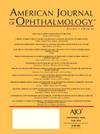Hormonal Contraception and Retinal Vascular Occlusion Risk
IF 4.1
1区 医学
Q1 OPHTHALMOLOGY
引用次数: 0
Abstract
Purpose
To investigate the association between hormonal contraceptive use and the risk of retinal vascular occlusions in women of reproductive age.
Design
Register-based, nationwide cohort study.
Participants
A total of 2,208,172 women aged 15-49 years were followed from January 1, 1996, to June 30, 2021, excluding those with prior venous or arterial thrombosis, thrombophilia, cancer (except non-melanoma skin cancer), liver disease, chronic kidney disease, hysterectomy, bilateral oophorectomy, hormone therapy, infertility treatment, endometriosis, or polycystic ovary syndrome.
Methods
Women were followed until study end, age 50, emigration, death, or occurrence of exclusion criteria. Individual-level, time-updated hormonal contraception use was identified through prescription records; retinal vascular occlusion events were detected through hospital diagnoses. Poisson regression models estimated incidence rate ratios of retinal vascular occlusion by duration, dosage, and type of hormonal contraceptives, adjusting for age, educational level, hypertension, diabetes, hypercholesterolemia, atrial fibrillation/flutter during observation.
Main Outcome Measures
Adjusted incidence rate ratios (AIRR) and standardized incidence rate differences (SIRD) of retinal vein occlusion and retinal artery occlusion with hormonal contraceptive use compared to non-use.
Results
The cohort contributed 23,882,016 person-years with a median follow-up time of 10 years (1st to 3rd quartile: 4 to 17). Compared to non-use, current hormonal contraception use was associated with a 40% increased rate of retinal vein occlusion (AIRR 1.4, 95% Confidence Interval (95% CI): 1.1-1.8), corresponding to SIRD of 4.6 (95% CI: 0.9-8.4) additional cases per 1,000,000 person-years. AIRR of retinal artery occlusion was 1.2 (95% CI: 0.8-1.7) with current hormonal contraception use compared to non-use.
The increased rate of retinal vein occlusion persisted with use of combined oral contraceptives containing 30-40 µg of estrogen (AIRR 1.6, 95% CI: 1.2-2.3), while no increased rate was observed with the low-dose 20 µg combined contraceptives (AIRR 0.7, 95% CI: 0.3-1.5). No increase observed with use of hormonal intrauterine devices.
Conclusion
Combined oral contraceptives containing 30-40 µg estrogen were associated with an increased rate of retinal vein occlusion compared to non-use, although the absolute increase was low. No increased rate was observed for retinal artery occlusions.
激素避孕与视网膜血管闭塞风险。
目的探讨育龄妇女使用激素避孕药与视网膜血管闭塞风险的关系。设计登记为基础的全国性队列研究。从1996年1月1日至2021年6月30日,共有2208172名年龄在15 - 49岁之间的女性接受了随访,排除了既往有静脉或动脉血栓形成、血栓形成、癌症(非黑色素瘤皮肤癌除外)、肝脏疾病、慢性肾脏疾病、子宫切除术、双侧卵巢切除术、激素治疗、不孕症治疗、子宫内膜异位症或多囊卵巢综合征的患者。方法随访妇女直至研究结束、年龄50岁、移民、死亡或出现排除标准。通过处方记录确定个体水平、时间更新的激素避孕使用情况;通过医院诊断检测视网膜血管闭塞事件。泊松回归模型估计视网膜血管闭塞的发生率比通过持续时间,剂量和激素避孕药的类型,调整年龄,教育水平,高血压,糖尿病,高胆固醇血症,心房颤动/扑动在观察期间。使用激素避孕药与未使用激素避孕药的视网膜静脉闭塞和视网膜动脉闭塞的校正发病率比(AIRR)和标准化发病率差(SIRD)。结果该队列贡献了23882016人年,中位随访时间为10年(第一至第三四分位数:4至17)。与不使用激素避孕相比,目前使用激素避孕与视网膜静脉闭塞率增加40%相关(AIRR为1.4,95%可信区间(95% CI): 1.1至1.8),对应于SIRD为每100万人年增加4.6例(95% CI: 0.9至8.4)。与未使用激素避孕相比,目前使用激素避孕的视网膜动脉闭塞的AIRR为1.2 (95% CI: 0.8 - 1.7)。使用含有30 ~ 40 μg雌激素的联合口服避孕药,视网膜静脉闭塞率持续升高(AIRR 1.6, 95% CI: 1.2 ~ 2.3),而使用低剂量20 μg联合避孕药,视网膜静脉闭塞率未升高(AIRR 0.7, 95% CI: 0.3 ~ 1.5)。使用激素宫内节育器未见增加。结论雌激素30 ~ 40 μg联合口服避孕药组视网膜静脉闭塞率较未使用组升高,但绝对升高率较低。视网膜动脉闭塞率未见增加。
本文章由计算机程序翻译,如有差异,请以英文原文为准。
求助全文
约1分钟内获得全文
求助全文
来源期刊
CiteScore
9.20
自引率
7.10%
发文量
406
审稿时长
36 days
期刊介绍:
The American Journal of Ophthalmology is a peer-reviewed, scientific publication that welcomes the submission of original, previously unpublished manuscripts directed to ophthalmologists and visual science specialists describing clinical investigations, clinical observations, and clinically relevant laboratory investigations. Published monthly since 1884, the full text of the American Journal of Ophthalmology and supplementary material are also presented online at www.AJO.com and on ScienceDirect.
The American Journal of Ophthalmology publishes Full-Length Articles, Perspectives, Editorials, Correspondences, Books Reports and Announcements. Brief Reports and Case Reports are no longer published. We recommend submitting Brief Reports and Case Reports to our companion publication, the American Journal of Ophthalmology Case Reports.
Manuscripts are accepted with the understanding that they have not been and will not be published elsewhere substantially in any format, and that there are no ethical problems with the content or data collection. Authors may be requested to produce the data upon which the manuscript is based and to answer expeditiously any questions about the manuscript or its authors.

 求助内容:
求助内容: 应助结果提醒方式:
应助结果提醒方式:


